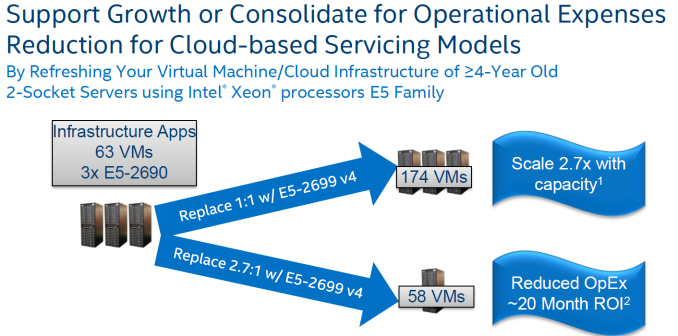The Intel Xeon E5 v4 Review: Testing Broadwell-EP With Demanding Server Workloads
by Johan De Gelas on March 31, 2016 12:30 PM EST- Posted in
- CPUs
- Intel
- Xeon
- Enterprise
- Enterprise CPUs
- Broadwell
Closing Thoughts
With the limited amount of time we had to spend with the new Broadwell-EP Xeons ahead of today's embargo, we spent most of our time on our new benchmarks. However we did a quick check on power as well. It looks like both idle power and load power when running a full floating point workload have decreased a little bit, but we need to do a more extensive check to further confirm and characterize this.
Meanwhile, considering what a wonderful offering the Xeon E5-2650L v3 was, it is a pitty that Intel did not include such a low power SKU among our samples for review. The Xeon E5-2699 v4 is a solid product, but it's not a home run. Either this is just an hiccup of our current setup (firmware?), but it seems the new Xeon E3 v4s do not reach the same turbo speeds as our Xeon E5 v3s. As a result, single threaded performance is (sometimes) slightly slower, and the new processor needs more cores to beat the previous one.
We noticed this mostly in the HPC applications, where the new Xeon is a bit of mixed bag. Still, considering that 72 to 88 threads are a bit much for lots of interesting applications (Spark, SQL databases...) there is definitely room for processors that sacrifice high core counts for higher single threaded performance (without exagerating). We have been stuck at 3.6 GHz for way too long.
With that said, there is little doubt that the Xeon E5-2699 v4 delivers in the one application that matter the most: virtualization.
Although we have not yet extensively tested on top of an hypervisor, we are pretty sure that the extra cores and the lower VMexit latencies will make this CPU perform well in virtualized environments. Intel's resource director technology and many improvements (posted interrupts) that help the hypervisor to perform better in I/O intensive tasks are very attractive features.
Although it is not much, as compared to the Haswell-EP based Xeon E5 v3s, performance has also increased by about 20% in key applications such as databases and ERP applications. And while we can complain all we want about the slightly regression in single threaded performance in some cases, the fact of the matter is that Intel has increased performance by 2 to 2.7 times in four years in those key applications, all the while holding power consumption at more or less the same. In other words, it will pay off to upgrade those Sandy Bridge-EP servers. And for many enterprises, that is what matters.











112 Comments
View All Comments
SkipPerk - Friday, April 8, 2016 - link
"Anyone putting Microsoft on bare hardware these days is nuts"This brother is speakin the truth!
warreo - Thursday, March 31, 2016 - link
Can someone clarify this line for me?"The average performance increase versus the Xeon E5-2690 is 3%, and the Broadwell cores get a boost of no less than 19%."
Does that mean IPC increase is 19% for Broadwell, offset by ~16% decline in clockspeed to get to 3% average performance increase? But that doesn't make sense to me as a 3.8ghz (E5-2690) to 3.6ghz (E5-2699 v4) is only 5% decline in max clockspeed?
ShieTar - Thursday, March 31, 2016 - link
I understood it as "the -Ofast setting boosts Broadwell by 19%", so with the -O2 setting it was actually 16% slower than the 2690.And I think the AT-Theory based on the original measurements is that the 3.6GHz boost are not even held for a significant amount of time, so that Broadwell in reality comes with an even worse decline in clock speed.
warreo - Thursday, March 31, 2016 - link
Your interpretation makes much more sense than mine, but still doesn't quite add up. The improvement from using -Ofast vs. -O2 is 13% on average, and the lowest improvement is 4% on the xalancbmk, well below the "no less than 19%" quoted by Johan.Perhaps the rest of the disparity is normalizing for sustained clock speeds as you suspect? Johan is that correct?
Ryan Smith - Thursday, March 31, 2016 - link
I've reworded that passage to make it clearer. But ShieTar's interpretation was basically correct."Switching from -O2 to -Ofast improves Broadwell-EP's absolute performance by over 19%. Meanwhile the relative performance advantage versus the Xeon E5-2690 averages 3%. "
JohanAnandtech - Thursday, March 31, 2016 - link
That means that the -ofast has much more effect on the Broadwell. I mean by that that -ofast is 19% faster than -o2 on Broadwell, while it is 3% faster on Sandy Bridge. I assume that the older the architecture, the better the compiler is able to optimize it without special tricks.warreo - Friday, April 1, 2016 - link
Thanks for the clarification. Loved the review, great work Johan!Pinn - Thursday, March 31, 2016 - link
I'm still happy I went with the 6 core x99 over the 8 core. Massive core count is nice to see available, but I don't see the true value. Looks like you have to do the same rough math to see if the clock speed reduction is worth the core count.Oxford Guy - Tuesday, April 5, 2016 - link
Why would there be "true value" for six and not for eight?Pinn - Wednesday, April 6, 2016 - link
Single threaded workloads.